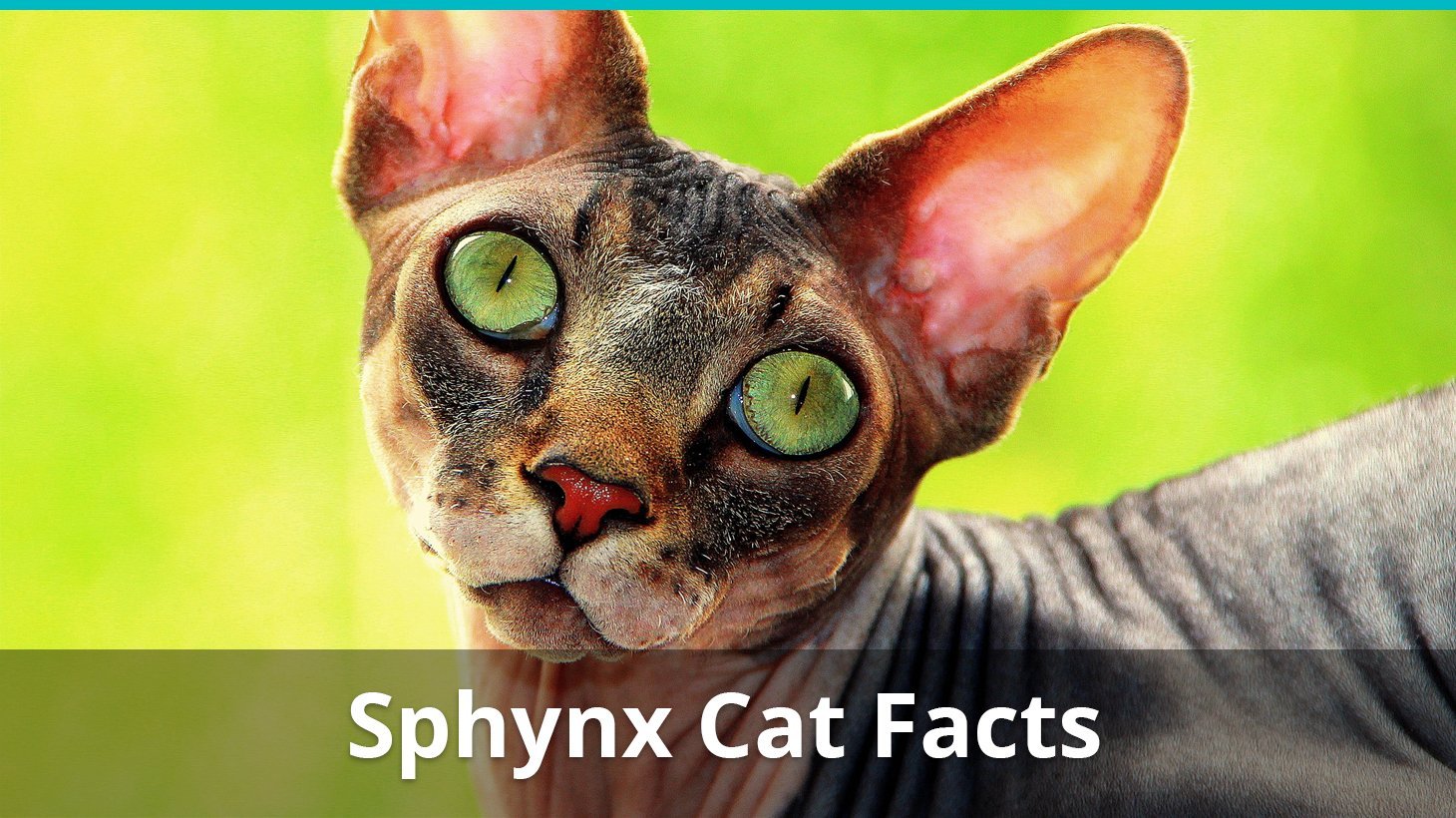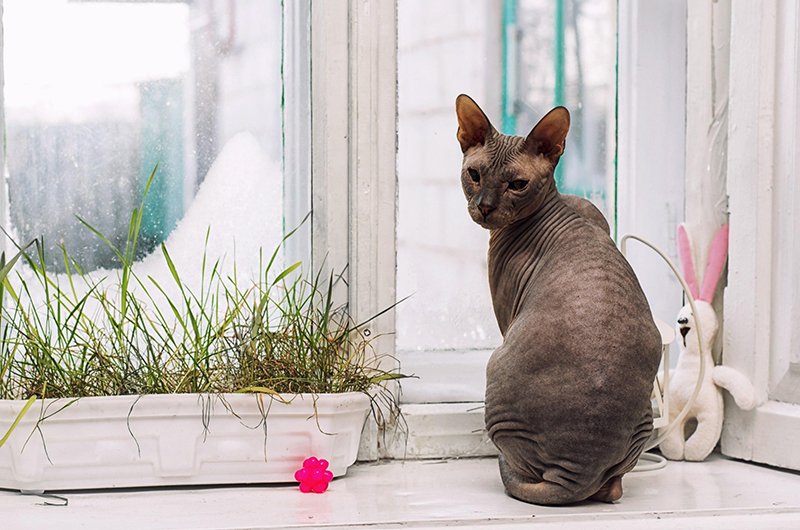The Sphynx cat is definitely a sight to see.
These felines are among the most eye-catching and distinctive cat breeds. Their striking physical appearance is as unique as their character. And while the Sphynx isn’t a pet for just anybody, it’s definitely among the most affable and affectionate kitties.
Many people consider them hypoallergenic, but unfortunately, that’s not the case. Sphynx kitties produce significant amounts of the Fel-d1 allergen agent, which causes cat allergies. However, the allergens they produce aren’t as high as those of many other cat breeds.
Sphynx cats are huggable and adore attention. They are happiest in the presence of their pet parents and remain notably affectionate and loyal to their owners.
Fun And Interesting Sphynx Cat And Kitten Facts And Information
They Aren’t Egyptian
A common misconception is that Sphynx cats are Egyptian. The myth originates from the Sphynx kitty’s distinctive physical appearance. They have long, seemingly hairless bodies that are muscular and end with notably thick paw pads. Their wedge-shaped heads, extra-large ears, and lemon-shaped eyes also give off the impression that they are somehow genetically related to felines that once inhabited Ancient Egypt.
However, Sphynx cats come from a colder spot on the world’s globe. Their true origin lies in Canada. The breed results from a natural gene mutation when one domestic shorthair kitty bore a hairless kitten in the 1960s. Through backcrossing, more hairless kittens were born, and people started breeding them purposefully.
The true Sphynx cat, often called the Canadian Sphynx, shouldn’t be mistaken for other hairless feline breeds, such as the Peterbald.
They Aren’t Bald
I know, right?! First, I tell you they aren’t Egyptian, and now I’m telling you they’re not bald. Is your whole life a lie?
Well, it’s true. A little-known fact about Sphynx is that these creatures are not bald. They are indeed “hairless,” but that doesn’t mean that they are completely bald.
These kitties have a thin and soft layer of mossy “fluff.” It cannot be considered hair, but it still counts for something. What’s more, this fluff is the reason why these cats are so awesome to the touch. Instead of feeling furry like other breeds, the hairless Sphynx cat is soft, velvety, and suede-like.
Dealing with cat hair is one problem you’ll never face if you own a Sphynx cat. And let’s face it—nobody wants their clothes, furniture, and even food covered in cat hair!
They Get Cold Easily (And Have A Higher Body Temperature To Compensate)
Some cats have a thick furry undercoat to keep them warm. Other furballs, like Ragdolls, lack an undercoat and have a single layer of fur. And then there are the Sphynx cats, which are completely hairless. Since they don’t have a fur coat, they get easily cold. To compensate for this, the Sphynx’s body temperature is four degrees hotter than the body temperature of most cat breeds.
However, they still get cold more easily than other cats. As such, the Sphynx is always seeking the warmest places in your home, even if this means sleeping in your bed instead of using its comfy cat bed. Moreover, it also loves being petted and enjoys snuggling with its owner for the same reason. Your Sphynx will spend significant parts of its time near all heat sources in your home.
If you’re one of those pet owners who like to dress up their pets, the Sphynx is the ideal domestic cat for the job. Cat clothing is one of the best ways to keep your Sphynx warm and healthy, and there are countless choices of cat apparel on the market these days.
Special Grooming Needs
The Sphynx cat has special grooming requirements. You might think that lacking hair means less grooming, and you’re partially correct. Sphynx kitties don’t require daily or weekly brushing but need weekly baths. Without regular baths, the cat’s skin will become greasy and stinky, attracting dirt and dust.
Since the Sphynx is a hairless cat, it has no fur to absorb the natural oils produced by its skin. As such, you need to bathe it weekly to eliminate the excess oils and keep your feline pal healthy and clean.
Social And Cuddly
The Sphynx is a social breed similar to the Oriental Shorthair cat. These feline creatures not only easily befriend strangers but also actively seek social interaction. Sphynx kitties enjoy all the attention they can get and are ideal for cuddling and snuggling all day.
Due to their notable sociability and strong attachment to their pet parents, Sphynx cats get lonely when they are left home alone for long periods. They are quite energetic and curious, and when left to their own devices, their loneliness might accelerate into destructive behavior.
If your job allows you to spend more time at home and you’re looking for an affectionate, cuddly, and loyal pet that doesn’t shed all over the place, then the Sphynx cat is a great choice.
Colorful Kitties
Even though this breed is hairless, that doesn’t mean it’s not colorful. Sphynx kitties come in a rich variety of colors. The different hues and patterns you can see are actually the kitty’s own skin pigmentation, as the thin layer of mossy fluff is actually colorless.
They can have tabby, solid, tortoiseshell, point, bicolor, or van patterns, and the pigmentation can be red, creamy, lavender, chocolate, black, brown, and so forth.
They Require Frequent Meals
Since this breed isn’t closely related to your average domestic kitty, it has special nutritional needs. The Sphynx produces more heat than the average domestic cat, and its metabolism works faster. This means that your fluffy pal will need to eat more frequently. Otherwise, it might suffer from malnourishment.
It is ideal to get an automatic feeder for your Sphynx cat so it can eat several small meals a day.
The best diet option for Sphynx kitties is high-quality cat food, mainly dry food, consisting of well-balanced meat-based products. As granules lack enough moisture, your kitty will need daily supplies of fresh water, which is essential for any feline furball.
Sphynx kitties thrive best on a dry food diet high in vitamins, taurine, minerals, and other important ingredients derived from meat products. Some cats may need special supplements, but you should never use them as a substitute for regular food.
How much do Sphynx cats and kittens cost? Price analysis and buying guide.
Sphynx cats aren’t for everyone, but that doesn’t mean they cost a small fortune. On the contrary! Compared to other domestic breeds with exotic looks, these hairless felines are actually affordable. You won’t need to spend a few thousand just to buy one.
- The starting price for Sphynx cats and kittens is around $900 – $1,200.
- Pure-bred, pedigreed Sphynx cats for shows will set you back at least $1,500.
- The prices in Europe, Canada, and the US are approximately the same, even though the breed is native to Canada.
- Beware of kittens advertised below $900. They may be mixes between Sphynx, Donskoy, and other breeds or have questionable health.
These show-stopping felines require special attention to temperature, food, and healthcare. As such, if you want to own a Sphynx cat, be prepared to spend much more than the initial price tag.
Pro buying guide tip: You won’t find these at every reputable mass breeder. Many consider these kitties repulsive or even creepy, so many breeders opt not to work with Sphynxes. Here’s another tip: don’t buy young Sphynx kittens. Due to their breed-specific health problems, getting an adult Sphynx at least a year old is better.
Health Problems To Look Out For
The health problems affecting this breed are as unique as the breed itself. While most cats are congenitally prone to developing hypertrophic cardiomyopathy disease, Sphynx cats don’t carry these genes by birth, but they still have a high chance of developing it. Another dangerous heart disease found in Sphynxes is mitral valve dysplasia.
Besides the fact that they can easily get cold, these cats can also overheat. Moreover, their lack of hair coat means they can develop skin cancer if they are exposed to direct sunlight over long periods.
Newborn Sphynx cats are more vulnerable than kittens from other domestic feline breeds. Because they don’t have protective fur, they are susceptible to developing respiratory issues. Adopting a Sphynx kitten before it reaches 12 weeks of age may pose health problems for the kitten since it’s not mature enough to transition to a new environment.
Maintaining the health and happiness of your Sphynx cat should always be your priority. These feline creatures are not only unique in their signature physical appearances, but their lovable, affectionate temper and loyalty make them so special. Monitor your kitty’s weight, bathe it weekly, and offer as much social interaction as possible. Your Sphynx cat will make you feel loved and cherished for all of your devotion.


